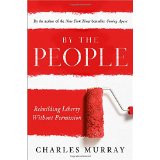Is Big Government an Abilene Paradox?
By Arnold Kling

… we moved from more than 3 out of 4 Americans who trusted the government in 1964 to fewer than 1 out of 7 in 2014.
… Americans with a wide range of political views have been disturbed by laws that are so complicated, they are impossible to obey; by a tax code riddled with favors for people with connections and filled with hazards for ordinary Americans; by laws that can send people to jail for things that other people have done; by occasions when property has been confiscated for reasons that seem patently unfair. They’ve seen people prosecuted for politically motivated reasons or for failing to comply with unreasonable regulations. They’ve watched politically connected people go unprosecuted.
—Charles Murray, By the People: Rebuilding Liberty Without Permission,1 page 123
Charles Murray argues that government in the United States has evolved in a direction that few people wanted. To remedy this, he proposes that private philanthropists create a legal defense fund to support individuals and businesses who defy unjustifiable regulations. He argues that this would encourage more disobedience, rally public support for government that is lighter and more rational, and lead government officials to change their ways.
Murray calls his tactical approach “civil disobedience.” Perhaps a better term would be “lawfare2,” the term used to describe bringing political battles into the courtroom.
Shortly after Murray’s book was released, the Washington Post ran a story that illustrates the sort of government behavior run amok that he describes. The story, headlined “How the IRS seized a man’s life savings without ever charging him with a crime,” described what happened when convenience store owner Lyndon McLellan deposited cash in the bank in amounts less than $10,000.
If you’re depositing sub-$10,000 amounts because that’s all you have on you, or because you don’t want to have big piles of cash sitting around your office, or for literally any reason other than “trying to hide it from the IRS,” you are doing nothing wrong.
But the IRS took his money anyway. As McLellan put it, “It took me 13 years to save that much money, and 13 seconds for the government to take it away.”3
McLellan had committed no crime and was never charged with any crime, but the Internal Revenue Service claimed the right to seize his money. He had been warned by the IRS that he should make larger deposits when possible and to fill out the extra paperwork required as a result. His choice instead to continue to make smaller deposits seems like the sort of civil disobedience that Murray would like to see backed by legal defense funds. Indeed, McLellan received free legal assistance from the Institute for Justice, which played the role that Murray would advocate.
Murray believes that two bursts of activity did much to fuel the regulatory state. From 1937 to 1942, a number of Supreme Court rulings removed many Constitutional limits on government.
In effect, the Supreme Court announced to the nation that the federal government could regulate just about any economic activity of any sort that it felt like regulating—indeed, as subsequent decades were to reveal, it could regulate even non-economic activities that had potential effects on economic activities that had potential effects on interstate commerce. (Murray, page 25)
The second burst came three decades later, during the Richard Nixon Administration.
From 1970 to 1974, sixteen new major regulatory agencies were established, including the EPA and OSHA, the two with the most sweeping influence. During the same period, the Supreme Court’s decision in Griggs v. Duke Power expanded the regulatory clout of the Equal Employment Opportunity Commission (EEOC). What set those three agencies apart from previous regulatory agencies were their unrestricted briefs. Not limited to a specific industry, each had economy-wide authority to regulate. (page 83)
Murray argues that most Americans regret the growth of intrusive federal regulations. However, the current system is too well entrenched to be altered through ordinary legislative or judicial channels.
Reading Murray’s claim that the state has evolved in a direction that few Americans want, I was reminded of a training video, called “The Abilene Paradox,”4 that has long been popular in corporations and other large organizations. The training video offers a parable in which a family needing an activity on a hot Sunday decides to take what proves to be an unpleasant drive, even though no one really wanted to go. The lesson of the video is that group dynamics can suppress opinions, even when those opinions are widely held. (You can find videos and information about the Abilene Paradox by searching YouTube and/or Google.5)
Is the current configuration of federal government power an Abilene Paradox? The two components of such a paradox are:
- 1. Most people really do not like the path that has been chosen.
- 2. The doubts and concerns about the path have not been articulated.
I am not sure that either of these factors are at work here. I am afraid that relatively few politically active Americans would say that over-regulation is their major source of dissatisfaction with the government. Many would like to see government regulation improved and enhanced, particularly in the financial arena. Few would like to see regulation scaled back dramatically.
I describe non-libertarian sentiment as arising from “Fear Of Others’ Liberty,” or FOOL. People do not mind having their liberty constrained if they want to see constraints put on the liberty of others. And I believe that many people fear what others will do if given more liberty.
Murray’s civil disobedience or lawfare would provide a new means by which opponents of excessive regulation could make their case. This would be important if the second factor in the Abilene Paradox were at work, meaning that doubts about the regulatory state have been held back rather than articulated. However, this does not seem to be the case. Opponents of regulation have been able to articulate our message. Our problem is that this message has not been as persuasive as we would like.
I have little optimism that Americans in large numbers will take up the fight against an overly intrusive federal government. Many Americans who have earned impressive educational credentials identify much more with the technocrat attempting to make the administrative state work than with the family or business frustrated by the challenge of regulatory compliance.
Probably the most effective approach for dealing with regulatory burdens is to use work-arounds rather than direct confrontation. In the 1990s, a popular saying among the digerati was, “The Internet interprets censorship as damage and routes around it.”6 Similarly, the market system attempts to route around regulation. The financial sector is particularly effective at this, creating money market funds to evade interest-rate ceilings, creating futures and options contracts in part to evade margin requirements, creating highly-rated mortgage securities to evade capital requirements,7 etc. Some of the “social network sharing services,” like Uber and AirBnB, can be viewed in part as business models based on regulatory evasion.
Going forward, I think that entrepreneurial work-arounds will continue to be more effective than direct disobedience in limiting the damage caused by misguided approaches to regulation. While I find much to agree with in Murray’s diagnosis of the problem, I was not persuaded by his proposed solution.
Charles Murray, By the People: Rebuilding Liberty Without Permission. Crown Forum, 2015.
“How the IRS seized a man’s life savings without ever charging him with a crime” (italics in original). Christopher Ingraham, Washington Post May15, 2015,
The video is based on Jerry B. Harvey’s “The Abilene Paradox: The Management of Agreement,” in Organizational Dynamics. Summer, 1988.
The trick to avoiding the Abilene Paradox is to induce people to bring hidden doubts to the surface. One technique that I have seen deployed usefully is “5-3-1” voting. As a group discussion approaches an apparent consensus, the facilitator will ask everyone to hold up 1, 3, or 5 fingers. If you hold up 5 fingers, it means that you enthusiastically advocate the proposal. If you hold up 1 finger, you are saying that you would veto the proposal if you could. If you hold up 3 fingers, you are willing to accept the proposal with reservations.The “votes” do not determine the outcome of the discussion. Instead, the point of 5-3-1 voting is to continue the discussion until all of the doubts and reservations about the proposal have been articulated and discussed. A decision-maker may adopt a proposal regardless of the number of people voting 1 or 3. However, the decision will be reached only after the people voting 1 or 3 have been asked to voice their concerns. Had the family in the Abilene Paradox used 5-3-1 voting, the misgivings of the 1s and 3s would have been articulated rather than held back, and this probably would have caused the family to avoid making a decision that they later regretted.
This line is usually attributed to John Gilmore, who according to Wikipedia articulated it to Time in 1993.
See my article, “The Regulator’s Calculation Problem”, Library of Economics and Liberty, April 6, 2015.
For more articles by Arnold Kling, see the Archive.

